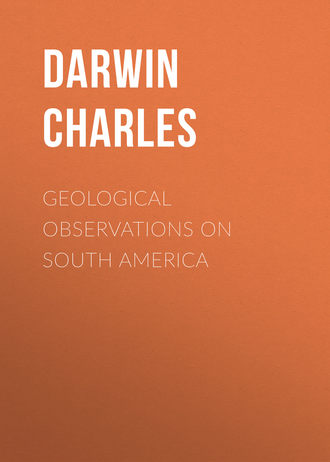 полная версия
полная версияGeological Observations on South America
THE NORTHERN PROVINCES OF LA PLATA.
According to some observations communicated to me by Mr. Fox, the coast from Rio de Janeiro to the mouth of the Plata seems everywhere to be granitic, with a few trappean dikes. At Port Alegre, near the boundary of Brazil, there are porphyries and diorites. (M. Isabelle "Voyage a Buenos Ayres" page 479.) At the mouth of the Plata, I examined the country for twenty-five miles west, and for about seventy miles north of Maldonado: near this town, there is some common gneiss, and much, in all parts of the country, of a coarse-grained mixture of quartz and reddish feldspar, often, however, assuming a little dark-green imperfect hornblende, and then immediately becoming foliated. The abrupt hillocks thus composed, as well as the highly inclined folia of the common varieties of gneiss, strike N.N.E. or a little more easterly, and S.S.W. Clay-slate is occasionally met with, and near the L. del Potrero, there is white marble, rendered fissile from the presence of hornblende, mica, and asbestus; the cleavage of these rocks and their stratification, that is the alternating masses thus composed, strike N.N.E. and S.S.W. like the foliated gneisses, and have an almost vertical dip. The Sierra Larga, a low range five miles west of Maldonado, consists of quartzite, often ferruginous, having an arenaceous feel, and divided into excessively thin, almost vertical laminae or folia by microscopically minute scales, apparently of mica, and striking in the usual N.N.E. and S.S.W. direction. The range itself is formed of one principal line with some subordinate ones; and it extends with remarkable uniformity far northward (it is said even to the confines of Brazil), in the same line with the vertically ribboned quartz rock of which it is composed. The S. de Las Animas is the highest range in the country; I estimated it at 1,000 feet; it runs north and south, and is formed of feldspathic porphyry; near its base there is a N.N.W. and S.S.E. ridge of a conglomerate in a highly porphyritic basis.
Northward of Maldonado, and south of Las Minas, there is an E. and W. hilly band of country, some miles in width, formed of siliceous clay-slate, with some quartz, rock, and limestone, having a tortuous irregular cleavage, generally ranging east and west. E. and S.E. of Las Minas there is a confused district of imperfect gneiss and laminated quartz, with the hills ranging in various directions, but with each separate hill generally running in the same line with the folia of the rocks of which it is composed: this confusion appears to have been caused by the intersection of the [E. and W.] and [N.N.E. and S.S.W.] strikes. Northward of Las Minas, the more regular northerly ranges predominate: from this place to near Polanco, we meet with the coarse-grained mixture of quartz and feldspar, often with the imperfect hornblende, and then becoming foliated in a N. and S. line – with imperfect clay-slate, including laminae of red crystallised feldspar – with white or black marble, sometimes containing asbestus and crystals of gypsum – with quartz-rock – with syenite – and lastly, with much granite. The marble and granite alternate repeatedly in apparently vertical masses: some miles northward of the Polanco, a wide district is said to be entirely composed of marble. It is remarkable, how rare mica is in the whole range of country north and westward of Maldonado. Throughout this district, the cleavage of the clay-slate and marble – the foliation of the gneiss and the quartz – the stratification or alternating masses of these several rocks – and the range of the hills, all coincide in direction; and although the country is only hilly, the planes of division are almost everywhere very highly inclined or vertical.
Some ancient submarine volcanic rocks are worth mentioning, from their rarity on this eastern side of the continent. In the valley of the Tapas (fifty or sixty miles N. of Maldonado) there is a tract three or four miles in length, composed of various trappean rocks with glassy feldspar – of apparently metamorphosed grit-stones – of purplish amygdaloids with large kernels of carbonate of lime (Near the Pan de Azucar there is some greenish porphyry, in one place amygdaloidal with agate.) – and much of a harshish rock with glassy feldspar intermediate in character between claystone porphyry and trachyte. This latter rock was in one spot remarkable from being full of drusy cavities, lined with quartz crystals, and arranged in planes, dipping at an angle of 50 degrees to the east, and striking parallel to the foliation of an adjoining hill composed of the common mixture of quartz, feldspar, and imperfect hornblende: this fact perhaps indicates that these volcanic rocks have been metamorphosed, and their constituent parts rearranged, at the same time and according to the same laws, with the granitic and metamorphic formations of this whole region. In the valley of the Marmaraya, a few miles south of the Tapas, a band of trappean and amygdaloidal rock is interposed between a hill of granite and an extensive surrounding formation of red conglomerate, which (like that at the foot of the S. Animas) has its basis porphyritic with crystals of feldspar, and which hence has certainly suffered metamorphosis.
MONTE VIDEO.
The rocks here consist of several varieties of gneiss, with the feldspar often yellowish, granular and imperfectly crystallised, alternating with, and passing insensibly into, beds, from a few yards to nearly a mile in thickness, of fine or coarse grained, dark-green hornblendic slate; this again often passing into chloritic schist. These passages seem chiefly due to changes in the mica, and its replacement by other minerals. At Rat Island I examined a mass of chloritic schist, only a few yards square, irregularly surrounded on all sides by the gneiss, and intricately penetrated by many curvilinear veins of quartz, which gradually BLEND into the gneiss: the cleavage of the chloritic schist and the foliation of the gneiss were exactly parallel. Eastward of the city there is much fine- grained, dark-coloured gneiss, almost assuming the character of hornblende- slate, which alternates in thin laminae with laminae of quartz, the whole mass being transversely intersected by numerous large veins of quartz: I particularly observed that these veins were absolutely continuous with the alternating laminae of quartz. In this case and at Rat Island, the passage of the gneiss into imperfect hornblendic or into chloritic slate, seemed to be connected with the segregation of the veins of quartz. (Mr. Greenough page 78 "Critical Examination" etc., observes that quartz in mica-slate sometimes appears in beds and sometimes in veins. Von Buch also in his "Travels in Norway" page 236, remarks on alternating laminae of quartz and hornblende-slate replacing mica-schist.)
The Mount, a hill believed to be 450 feet in height, from which the place takes its name, is much the highest land in this neighbourhood: it consists of hornblendic slate, which (except on the eastern and disturbed base) has an east and west nearly vertical cleavage; the longer axis of the hill also ranges in this same line. Near the summit the hornblende-slate gradually becomes more and more coarsely crystallised, and less plainly laminated, until it passes into a heavy, sonorous greenstone, with a slaty conchoidal fracture; the laminae on the north and south sides near the summit dip inwards, as if this upper part had expanded or bulged outwards. This greenstone must, I conceive, be considered as metamorphosed hornblende- slate. The Cerrito, the next highest, but much less elevated point, is almost similarly composed. In the more western parts of the province, besides gneiss, there is quartz-rock, syenite, and granite; and at Colla, I heard of marble.
Near M. Video, the space which I more accurately examined was about fifteen miles in an east and west line, and here I found the foliation of the gneiss and the cleavage of the slates generally well developed, and extending parallel to the alternating strata composed of the gneiss, hornblendic and chloritic schists. These planes of division all range within one point of east and west, frequently east by south and west by north; their dip is generally almost vertical, and scarcely anywhere under 45 degrees: this fact, considering how slightly undulatory the surface of the country is, deserves attention. Westward of M. Video, towards the Uruguay, wherever the gneiss is exposed, the highly inclined folia are seen striking in the same direction; I must except one spot where the strike was N.W. by W. The little Sierra de S. Juan, formed of gneiss and laminated quartz, must also be excepted, for it ranges between [N. to N.E.] and [S. to S.W.] and seems to belong to the same system with the hills in the Maldonado district. Finally, we have seen that, for many miles northward of Maldonado and for twenty-five miles westward of it, as far as the S. de las Animas, the foliation, cleavage, so-called stratification and lines of hills, all range N.N.E. and S.S.W., which is nearly coincident with the adjoining coast of the Atlantic. Westward of the S. de las Animas, as far as even the Uruguay, the foliation, cleavage, and stratification (but not lines of hills, for there are no defined ones) all range about E. by S. and W. by N., which is nearly coincident with the direction of the northern shore of the Plata; in the confused country near Las Minas, where these two great systems appear to intersect each other, the cleavage, foliation, and stratification run in various directions, but generally coincide with the line of each separate hill.
SOUTHERN LA PLATA.
The first ridge, south of the Plata, which projects through the Pampean formation, is the Sierra Tapalguen and Vulcan, situated 200 miles southward of the district just described. This ridge is only a few hundred feet in height, and runs from C. Corrientes in a W.N.W. line for at least 150 miles into the interior: at Tapalguen, it is composed of unstratified granular quartz, remarkable from forming tabular masses and small plains, surrounded by precipitous cliffs: other parts of the range are said to consist of granite: and marble is found at the S. Tinta. It appears from M. Parchappe's observations, that at Tandil there is a range of quartzose gneiss, very like the rocks of the S. Larga near Maldonado, running in the same N.N.E. and S.S.W. direction; so that the framework of the country here is very similar to that on the northern shore of the Plata. (M. d'Orbigny's "Voyage" Part. Geolog. page 46. I have given a short account of the peculiar forms of the quartz hills of Tapalguen, so unusual in a metamorphic formation, in my "Journal of Researches" 2nd edition page 116.)
The Sierra Guitru-gueyu is situated sixty miles south of the S. Tapalguen: it consists of numerous parallel, sometimes blended together ridges, about twenty-three miles in width, and five hundred feet in height above the plain, and extending in a N.W. and S.E. direction. Skirting round the extreme S.E. termination, I ascended only a few points, which were composed of a fine-grained gneiss, almost composed of feldspar with a little mica, and passing in the upper parts of the hills into a rather compact purplish clay-slate. The cleavage was nearly vertical, striking in a N.W. by W. and S.E. by E. line, nearly, though not quite, coincident with the direction of the parallel ridges.
The Sierra Ventana lies close south of that of Guitru-gueyu; it is remarkable from attaining a height, very unusual on this side of the continent, of 3,340 feet. It consists up to its summit, of quartz, generally pure and white, but sometimes reddish, and divided into thick laminae or strata: in one part there is a little glossy clay-slate with a tortuous cleavage. The thick layers of quartz strike in a W. 30 degrees N. line, dipping southerly at an angle of 45 degrees and upwards. The principal line of mountains, with some quite subordinate parallel ridges, range about W. 45 degrees N.: but at their S.E. termination, only W. 25 degrees N. This Sierra is said to extend between twenty and thirty leagues into the interior.
PATAGONIA.
With the exception perhaps of the hill of S. Antonio (600 feet high) in the Gulf of S. Matias, which has never been visited by a geologist, crystalline rocks are not met with on the coast of Patagonia for a space of 380 miles south of the S. Ventana. At this point (latitude 43 degrees 50 minutes), at Points Union and Tombo, plutonic rocks are said to appear, and are found, at rather wide intervals, beneath the Patagonian tertiary formation for a space of about three hundred miles southward, to near Bird Island, in latitude 48 degrees 56 minutes. Judging from specimens kindly collected for me by Mr. Stokes, the prevailing rock at Ports St. Elena, Camerones, Malaspina, and as far south as the Paps of Pineda, is a purplish-pink or brownish claystone porphyry, sometimes laminated, sometimes slightly vesicular, with crystals of opaque feldspar and with a few grains of quartz; hence these porphyries resemble those immediately to be described at Port Desire, and likewise a series which I have seen from P. Alegre on the southern confines of Brazil. This porphyritic formation further resembles in a singularly close manner the lowest stratified formation of the Cordillera of Chile, which, as we shall hereafter see, has a vast range, and attains a great thickness. At the bottom of the Gulf of St. George, only tertiary deposits appear to be present. At Cape Blanco, there is quartz rock, very like that of the Falkland Islands, and some hard, blue siliceous clay-slate.
At Port Desire there is an extensive formation of the claystone porphyry, stretching at least twenty-five miles into the interior: it has been denuded and deeply worn into gullies before being covered up by the tertiary deposits, through which it here and there projects in hills; those north of the bay being 440 feet in height. The strata have in several places been tilted at small angles, generally either to N.N.W. or S.S.E. By gradual passages and alternations, the porphyries change incessantly in nature. I will describe only some of the principal mineralogical changes, which are highly instructive, and which I carefully examined. The prevailing rock has a compact purplish base, with crystals of earthy or opaque feldspar, and often with grains of quartz. There are other varieties, with an almost truly trachytic base, full of little angular vesicles and crystals of glassy feldspar; and there are beds of black perfect pitchstone, as well as of a concretionary imperfect variety. On a casual inspection, the whole series would be thought to be of the same plutonic or volcanic nature with the trachytic varieties and pitchstone; but this is far from being the case, as much of the porphyry is certainly of metamorphic origin. Besides the true porphyries, there are many beds of earthy, quite white or yellowish, friable, easily fusible matter, resembling chalk, which under the microscope is seen to consist of minute broken crystals, and which, as remarked in a former chapter, singularly resembles the upper tufaceous beds of the Patagonian tertiary formation. This earthy substance often becomes coarser, and contains minute rounded fragments of porphyries and rounded grains of quartz, and in one case so many of the latter as to resemble a common sandstone. These beds are sometimes marked with true lines of aqueous deposition, separating particles of different degrees of coarseness; in other cases there are parallel ferruginous lines not of true deposition, as shown by the arrangement of the particles, though singularly resembling them. The more indurated varieties often include many small and some larger angular cavities, which appear due to the removal of earthy matter: some varieties contain mica. All these earthy and generally white stones insensibly pass into more indurated sonorous varieties, breaking with a conchoidal fracture, yet of small specific gravity; many of these latter varieties assume a pale purple tint, being singularly banded and veined with different shades, and often become plainly porphyritic with crystals of feldspar. The formation of these crystals could be most clearly traced by minute angular and often partially hollow patches of earthy matter, first assuming a FIBROUS STRUCTURE, then passing into opaque imperfectly shaped crystals, and lastly, into perfect glassy crystals. When these crystals have appeared, and when the basis has become compact, the rock in many places could not be distinguished from a true claystone porphyry without a trace of mechanical structure.
In some parts, these earthy or tufaceous beds pass into jaspery and into beautifully mottled and banded porcelain rocks, which break into splinters, translucent at their edges, hard enough to scratch glass, and fusible into white transparent beads: grains of quartz included in the porcelainous varieties can be seen melting into the surrounding paste. In other parts, the earthy or tufaceous beds either insensibly pass into, or alternate with, breccias composed of large and small fragments of various purplish porphyries, with the matrix generally porphyritic: these breccias, though their subaqueous origin is in many places shown both by the arrangement of their smaller particles and by an oblique or current lamination, also pass into porphyries, in which every trace of mechanical origin and stratification has been obliterated.
Some highly porphyritic though coarse-grained masses, evidently of sedimentary origin, and divided into thin layers, differing from each other chiefly in the number of embedded grains of quartz, interested me much from the peculiar manner in which here and there some of the layers terminated in abrupt points, quite unlike those produced by a layer of sediment naturally thinning out, and apparently the result of a subsequent process of metamorphic aggregation. In another common variety of a finer texture, the aggregating process had gone further, for the whole mass consisted of quite short, parallel, often slightly curved layers or patches, of whitish or reddish finely granulo-crystalline feldspathic matter, generally terminating at both ends in blunt points; these layers or patches further tended to pass into wedge or almond-shaped little masses, and these finally into true crystals of feldspar, with their centres often slightly drusy. The series was so perfect that I could not doubt that these large crystals, which had their longer axes placed parallel to each other, had primarily originated in the metamorphosis and aggregation of alternating layers of tuff; and hence their parallel position must be attributed (unexpected though the conclusion may be), not to laws of chemical action, but to the original planes of deposition. I am tempted briefly to describe three other singular allied varieties of rock; the first without examination would have passed for a stratified porphyritic breccia, but all the included angular fragments consisted of a border of pinkish crystalline feldspathic matter, surrounding a dark translucent siliceous centre, in which grains of quartz not quite blended into the paste could be distinguished: this uniformity in the nature of the fragments shows that they are not of mechanical, but of concretionary origin, having resulted perhaps from the self-breaking up and aggregation of layers of indurated tuff containing numerous grains of quartz, – into which, indeed, the whole mass in one part passed. The second variety is a reddish non-porphyritic claystone, quite full of spherical cavities, about half an inch in diameter, each lined with a collapsed crust formed of crystals of quartz. The third variety also consists of a pale purple non-porphyritic claystone, almost wholly formed of concretionary balls, obscurely arranged in layers, of a less compact and paler coloured claystone; each ball being on one side partly hollow and lined with crystals of quartz.
PSEUDO-DIKES.
Some miles up the harbour, in a line of cliffs formed of slightly metamorphosed tufaceous and porphyritic claystone beds, I observed three vertical dikes, so closely resembling in general appearance ordinary volcanic dikes, that I did not doubt, until closely examining their composition, that they had been injected from below. The first is straight, with parallel sides, and about four feet wide; it consists of whitish, indurated tufaceous matter, precisely like some of the beds intersected by it. The second dike is more remarkable; it is slightly tortuous, about eighteen inches thick, and can be traced for a considerable distance along the beach; it is of a purplish-red or brown colour, and is formed chiefly of ROUNDED grains of quartz, with broken crystals of earthy feldspar, scales of black mica, and minute fragments of claystone porphyry, all firmly united together in a hard sparing base. The structure of this dike shows obviously that it is of mechanical and sedimentary origin; yet it thinned out upwards, and did not cut through the uppermost strata in the cliffs. This fact at first appears to indicate that the matter could not have been washed in from above (Upfilled fissures are known to occur both in volcanic and in ordinary sedimentary formations. At the Galapagos Archipelago "Volcanic Islands" etc., there are some striking examples of pseudo-dikes composed of hard tuff.); but if we reflect on the suction which would result from a deep-seated fissure being formed, we may admit that if the fissure were in any part open to the surface, mud and water might well be drawn into it along its whole course. The third dike consisted of a hard, rough, white rock, almost composed of broken crystals of glassy feldspar, with numerous scales of black mica, cemented in a scanty base; there was little in the appearance of this rock, to preclude the idea of its having been a true injected feldspathic dike. The matter composing these three pseudo-dikes, especially the second one, appears to have suffered, like the surrounding strata, a certain degree of metamorphic action; and this has much aided the deceptive appearance. At Bahia, in Brazil, we have seen that a true injected hornblendic dike, not only has suffered metamorphosis, but has been dislocated and even diffused in the surrounding gneiss, under the form of separate crystals and of fragments.
FALKLAND ISLANDS.
I have described these islands in a paper published in the third volume of the "Geological Journal." The mountain-ridges consist of quartz, and the lower country of clay-slate and sandstone, the latter containing Palaeozoic fossils. These fossils have been separately described by Messrs. Morris and Sharpe: some of them resemble Silurian, and others Devonian forms. In the eastern part of the group the several parallel ridges of quartz extend in a west and east line; but further westward the line becomes W.N.W. and E.S.E., and even still more northerly. The cleavage-planes of the clay- slate are highly inclined, generally at an angle of above 50 degrees, and often vertical; they strike almost invariably in the same direction with the quartz ranges. The outline of the indented shores of the two main islands, and the relative positions of the smaller islets, accord with the strike both of the main axes of elevation and of the cleavage of the clay- slate.
TIERRA DEL FUEGO.
My notes on the geology of this country are copious, but as they are unimportant, and as fossils were found only in one district, a brief sketch will be here sufficient. The east coast from the S. of Magellan (where the boulder formation is largely developed) to St. Polycarp's Bay is formed of horizontal tertiary strata, bounded some way towards the interior by a broad mountainous band of clay-slate. This great clay-slate formation extends from St. Le Maire westward for 140 miles, along both sides of the Beagle Channel to near its bifurcation. South of this channel, it forms all Navarin Island, and the eastern half of Hoste Island and of Hardy Peninsula; north of the Beagle Channel it extends in a north-west line on both sides of Admiralty Sound to Brunswick Peninsula in the St. of Magellan, and I have reason to believe, stretches far up the eastern side of the Cordillera. The western and broken side of Tierra del Fuego towards the Pacific is formed of metamorphic schists, granite and various trappean rocks: the line of separation between the crystalline and clay-slate formations can generally be distinguished, as remarked by Captain King, by the parallelism in the clay-slate districts of the shores and channels, ranging in a line between [W. 20 degrees to 40 degrees N.] and [E. 20 degrees to 40 degrees S.]. ("Geographical Journal" volume 1 page 155.)











